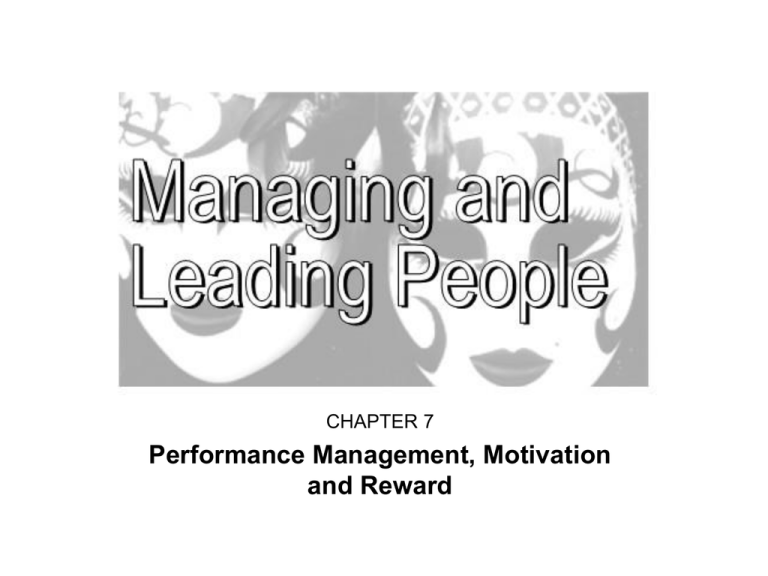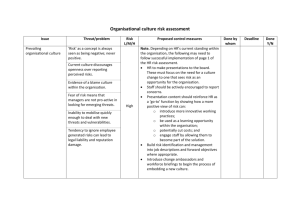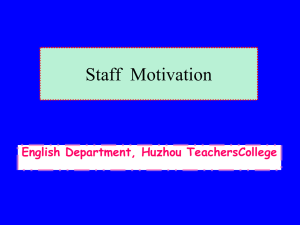Managing and Leading People in High Performance
advertisement

CHAPTER 7 Performance Management, Motivation and Reward Performance management, motivation and reward • Different ways that performance management (PM) can be defined and interpreted • Assumptions that underpin the application of performance management • The contribution of differing theories in the development of PM • The relationship between performance, motivation and reward • Evaluating how PM improves organisational effectiveness and efficiency Definitions of performance management • ‘The outcomes of work because they provide the strongest linkage to the strategic goals of the organisation, customer satisfaction, and economic contributions’ (Bernadin, 1995) • ‘Performance means both behaviours and results. Behaviours emanate from the performer and transform performance from abstraction to action. Not just the instruments for results, behaviours are also outcomes in their own right – the product of mental and physical effort applied to tasks – and can be judged from the results’ (Brumbach, 1988) Perspectives on performance management • Controlling performance – managerial perspective • The Eternal Triangle – organisational theory, industrial engineering and behavioural science • Aligning individual and organisational needs – fit person to job or fit job to person • Stakeholder benefit – shareholders’, customers’, employees’ views Linking HR and performance management Corporate strategy Strategic goals Group/team objectives Supportive HR policies and procedures Individual objectives Organisational performance Performance gap Organisational objectives Group/team performance Measuring, assessing and monitoring performance (including feedback and appraisal) Individual performance Actual outcomes Desired outcomes HR supporting mechanisms: Eg development and training, continuing professional development, personal development planning, career planning, recognition and reward Performance management, motivation and reward motivation Performance management job satisfaction performance Performance management, motivation and reward Assumptions: • Motivation leads/can lead to increased performance (content and process theories) • Job satisfaction does not/may not lead to increased performance (process theories) • Rewards may or may not lead to increased motivation (and increased performance) • Rewards may or may not lead to increased job satisfaction (and increased performance) What shapes motivation? • Four basic emotional needs or drives – to: Acquire Bond Comprehend Defend (through reward system) (through culture) (through job design) (through fairness of work assessment) (Source: Nohria, 2008; p.82) Performance appraisal Two major approaches: Results-oriented (outputs) Based upon setting quantifiable, achievable and time-bound objectives, between manager and subordinate Competence-oriented (inputs) Based upon the demonstration of key skills and behaviours associated with high performance Factors affecting performance • • • • • Personal/individual characteristics Job-related factors The performance management system Organisational factors Extra-organisational factors Uses of performance management data • To demonstrate an organisation’s ability to raise competence levels • To assess how long it takes for a new employee to reach optimum performance • To provide feedback on development programmes • To demonstrate the success of internal recruitment programmes • To indicate how successful an organisation is at achieving its objectives • To track skills levels and movement in skills gaps (Source: Armstrong and Baron, 2007; p.111) Techniques to improve performance • • • • • • • • • Learning Development Training Coaching, mentoring Team-building Culture-change programmes Reward schemes Structure, process, systems, job-redesign, etc Management approach References • Armstrong, M. and Baron, A. (2007) Human Capital Management: Achieving added value through people. London: Kogan Page. • Bernadin, H. K., Kane, J. S. and Ross, S. (1995) ‘Performance appraisal design, development and implementation’, in Ferris, G. R., Rosen, S. D. and Barnum, D. J. (eds) Handbook of Human Resource Management. Cambridge, MA: Blackwell. • Brumbach, G. B. (1988) ‘Some ideas, issues and predictions about performance management’, Public Personnel Management, Winter: 387–402. • Nohria,N., Groysberg, B. and Lee, L.-E. (2008) ‘Employee motivation: a powerful new model’, Harvard Business Review, July-August.







